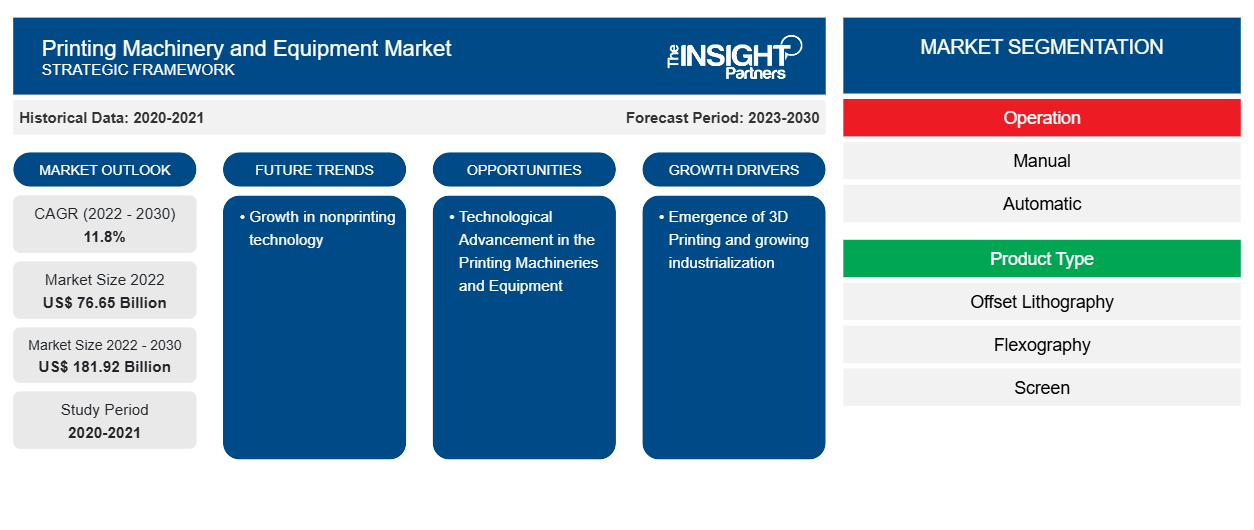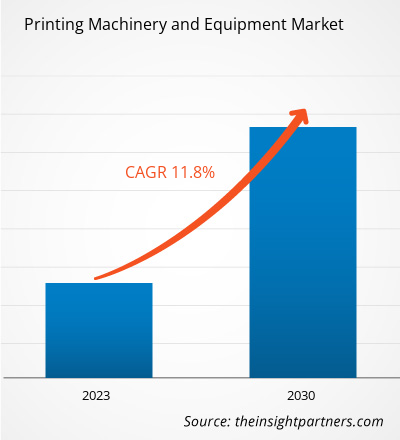The Printing Machinery and Equipment market is projected to grow from US$ 76.65 billion in 2022 to US$ 181.92 billion by 2030; it is expected to expand at a CAGR of 11.8% from 2022 to 2030. Growth in nonprinting technology is expected to be a key trend in the market.
Printing Machinery and Equipment Market Analysis
Printing equipment has become an integral part of daily lives, since it is frequently utilized in offices, institutions, and enterprises to make any information accessible. The worldwide printing machinery and equipment market has enormous development potential and is likely to expand at a rapid pace in the coming years. Outdoor billboards, posters, adhesive wall/floor prints, and custom packaging all require specialized machinery. As a result, the demand from both indoor and outdoor signage producers, as well as package designers is expected to grow during the forecast period.
Printing Machinery and Equipment Market Industry Overview
A printer is an output device that prints text or images onto a medium known as a substrate. Digital printers are frequently connected to computers, either wirelessly or via USB connection. Printing gear and equipment are frequently used in industries to print many types of information, such as images and texts, among others.
Customize This Report To Suit Your Requirement
You will get customization on any report - free of charge - including parts of this report, or country-level analysis, Excel Data pack, as well as avail great offers and discounts for start-ups & universities
Printing Machinery and Equipment Market: Strategic Insights

-
Get Top Key Market Trends of this report.This FREE sample will include data analysis, ranging from market trends to estimates and forecasts.
Printing Machinery and Equipment Market Driver and Opportunities
Emergence of 3D Printing to Favor Market Growth
The number of companies utilizing 3D printing has increased dramatically as the technology has evolved. The applications and use cases vary by industry, but they typically include tooling aids, visual and functional prototypes, and even end-use parts. In February 2021, Xerox Holdings Corp and the Naval Postgraduate School (NPS) entered into a strategic partnership on developing additive manufacturing technology, notably 3D printing, which has the potential to revolutionize how the military feeds its forward-deployed forces drastically. This relationship assisted NPS in accelerating 3D printing adoption throughout the US Navy and provided Xerox with vital information to help prospective customers achieve supply chain flexibility and robustness. Such developments are expected to drive the printing machinery and equipment market growth during the forecast period.
Technological Advancement in the Printing Machineries and Equipment
Key market participants are focusing on technological advancements. For instance, in March 2024, HP Development Company, L.P. announced the launch of a new HP Indigo 120K Digital Press for best-in-class productivity1, 18K Digital Press handling the widest range of print applications ever produced with a single B2 digital press2. Further, in April 2024, Kings 3D launched new products, adding to its four major product lines: metal 3D printing, five-axis additive and subtractive manufacturing, high-speed line forming (HSLA), and arc additive manufacturing. Such advancement in the market is expected to boost the market growth during the forecast period.
Printing Machinery and Equipment Market Report Segmentation Analysis
The key segments that contributed to the derivation of the Printing Machinery and Equipment market analysis are coverage by operation, product type, substrate type, and end-use.
- By operation, the market is divided into manual and automatic. Automatic printing includes all types of all-in-one printers, digital printers, offset lithography printers, flexography printers, thermal printers, and 3D printers, among others.
- By product type, the market is segmented into offset lithography, flexography, screen, digital, and others.
- The offset lithography segment is expected to grow significantly during the forecast period.
- By substrate type, the market is divided into plastic, paper & paperboard, metal, and others.
- By end use, the market is segmented into commercial, publication, and others.
Printing Machinery and Equipment Market Share Analysis By Geography
Based on region, the market is segmented into North America, Europe, Asia Pacific, Middle East & Africa, and South & Central America.
North America held a prominent share of the printing machinery and equipment market in 2022. Key market players in this region are focusing on technological advancement and new product launches. For instance, in April 2022, 3D Systems Inc. introduced a new SLA 750 stereolithography additive manufacturing (AM) solution. It is intended for large format or high-volume production applications, and it includes the SLA 750 and SLA 750 Dual - the first synchronous, dual-laser stereolithography printers - as well as the Accura AMX Durable Natural material and the PostCureTM 1050 post-processing system. Further, the market in the Asia Pacific region is expected to grow significantly during the forecast period. Growth in the manufacturing sector and other industrialization are the major factors contributing to the region’s growth.
Printing Machinery and Equipment Market Regional InsightsThe regional trends and factors influencing the Printing Machinery and Equipment Market throughout the forecast period have been thoroughly explained by the analysts at The Insight Partners. This section also discusses Printing Machinery and Equipment Market segments and geography across North America, Europe, Asia Pacific, Middle East and Africa, and South and Central America.
Printing Machinery and Equipment Market Report Scope
| Report Attribute | Details |
|---|---|
| Market size in 2022 | US$ 76.65 Billion |
| Market Size by 2030 | US$ 181.92 Billion |
| Global CAGR (2022 - 2030) | 11.8% |
| Historical Data | 2020-2021 |
| Forecast period | 2023-2030 |
| Segments Covered |
By Operation
|
| Regions and Countries Covered |
North America
|
| Market leaders and key company profiles |
|
Printing Machinery and Equipment Market Players Density: Understanding Its Impact on Business Dynamics
The Printing Machinery and Equipment Market is growing rapidly, driven by increasing end-user demand due to factors such as evolving consumer preferences, technological advancements, and greater awareness of the product's benefits. As demand rises, businesses are expanding their offerings, innovating to meet consumer needs, and capitalizing on emerging trends, which further fuels market growth.

- Get the Printing Machinery and Equipment Market top key players overview
Printing Machinery and Equipment Market News and Recent Developments
The Printing Machinery and Equipment market is evaluated by gathering qualitative and quantitative data post primary and secondary research, which includes important corporate publications, association data, and databases. A few of the developments in the Printing Machinery and Equipment Market are listed below:
- Fujifilm Corporation announced the launch of new integrated inkjet products at Drupa 2024. The new Fujifilm DE1024 digital embellishment printbar system and Fujifilm 42X printbar system are designed to enhance printing capabilities for several applications, including commercial printing, packaging and labels, security printing, and personal care. (Source: Fujifilm Corporation, Press Release, April 2024)
Printing Machinery and Equipment Market Report Coverage & Deliverables
The Printing Machinery and Equipment market forecast is estimated based on various secondary and primary research findings, such as key company publications, association data, and databases. The market report "Printing Machinery and Equipment Market Size and Forecast (2020–2030)" provides a detailed analysis of the market covering below areas-
- Printing Machinery and Equipment Market size and forecast at global, regional, and country levels for all the key market segments covered under the scope
- Printing Machinery and Equipment Market trends, as well as market dynamics such as drivers, restraints, and key opportunities
- Detailed PEST/Porter’s Five Forces and SWOT analysis
- Printing Machinery and Equipment Market analysis covering key market trends, global and regional framework, major players, regulations, and recent market developments
- Industry landscape and competition analysis covering market concentration, heat map analysis, prominent players, and recent developments in the Printing Machinery and Equipment Market
- Detailed company profiles.
Frequently Asked Questions
Which are the leading players operating in the Printing Machinery and Equipment market?
What are the deliverable formats of the Printing Machinery and Equipment market report?
What are the options available for the customization of this report?
What is the expected CAGR of the Printing Machinery and Equipment market?
What are the driving factors impacting the Printing Machinery and Equipment market?
What are the future trends of the Printing Machinery and Equipment market?
- Historical Analysis (2 Years), Base Year, Forecast (7 Years) with CAGR
- PEST and SWOT Analysis
- Market Size Value / Volume - Global, Regional, Country
- Industry and Competitive Landscape
- Excel Dataset
Recent Reports
Testimonials
Reason to Buy
- Informed Decision-Making
- Understanding Market Dynamics
- Competitive Analysis
- Identifying Emerging Markets
- Customer Insights
- Market Forecasts
- Risk Mitigation
- Boosting Operational Efficiency
- Strategic Planning
- Investment Justification
- Tracking Industry Innovations
- Aligning with Regulatory Trends





















 Get Free Sample For
Get Free Sample For